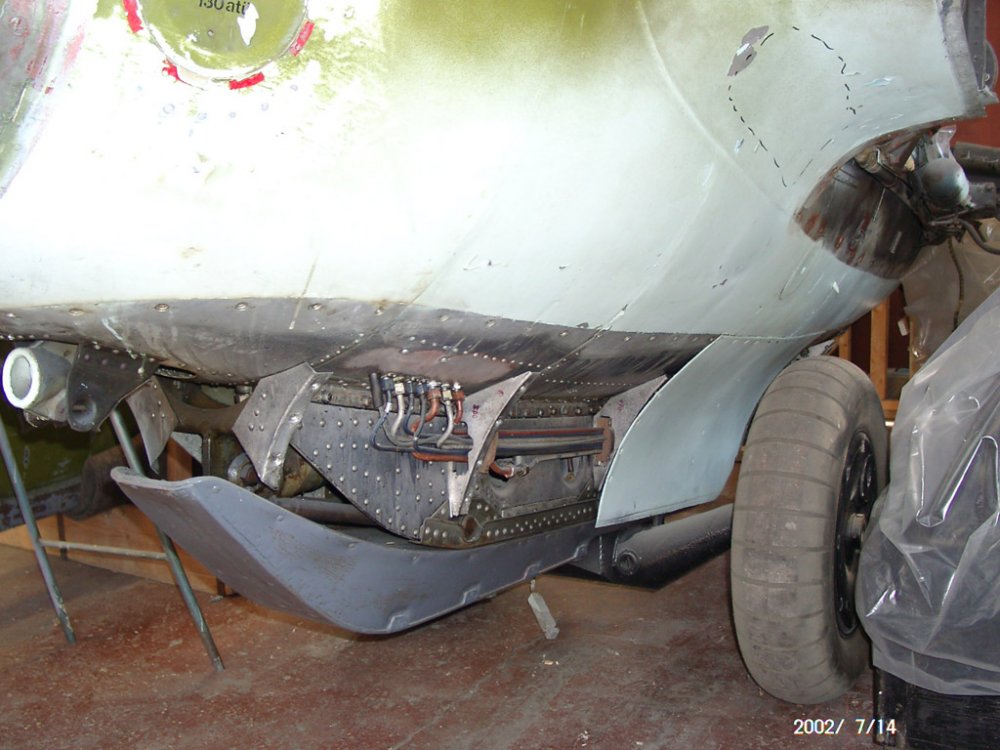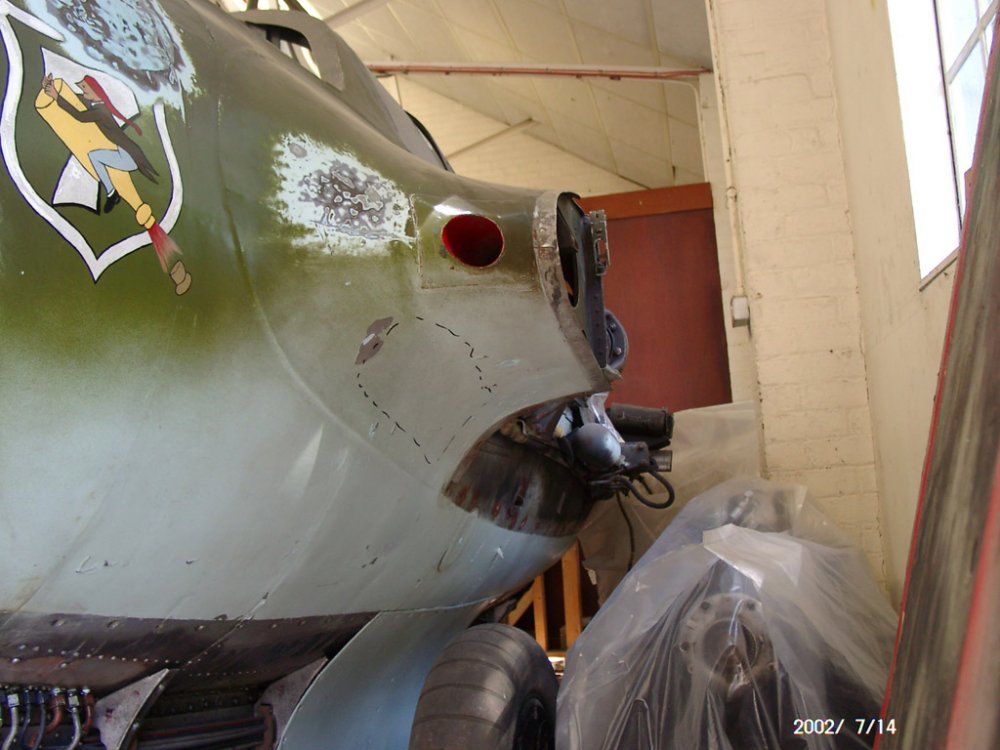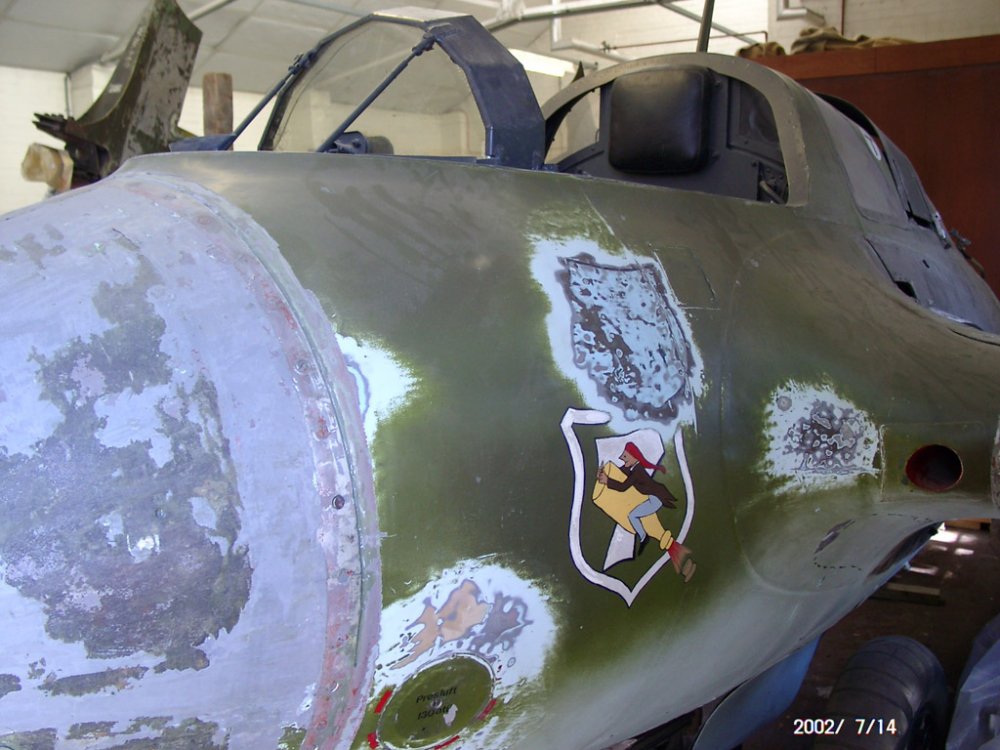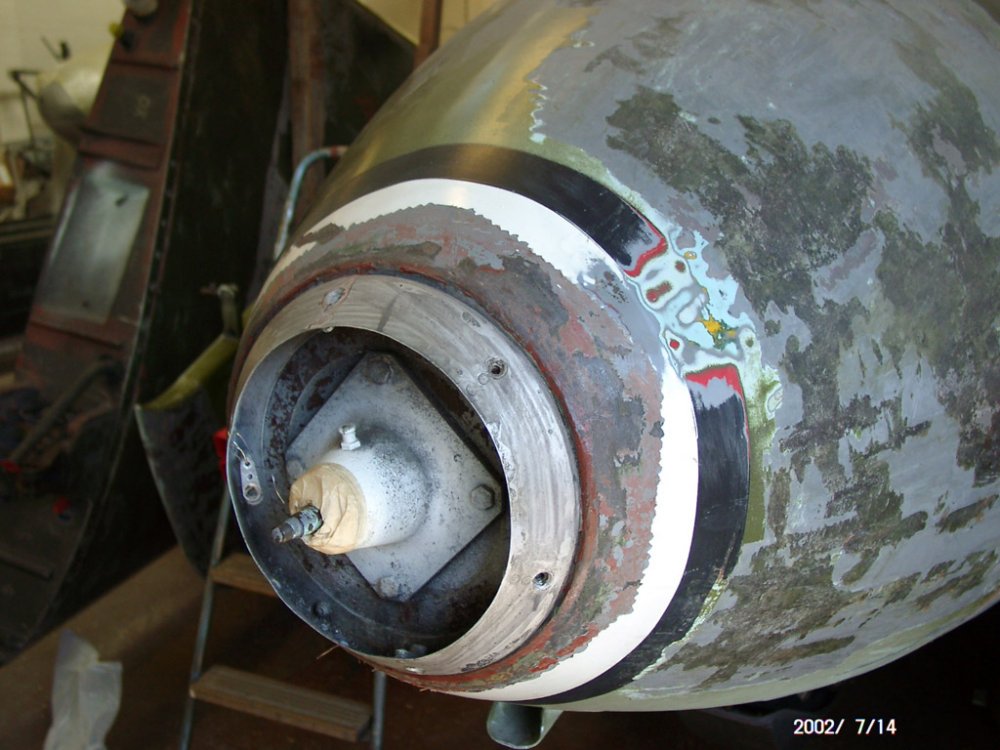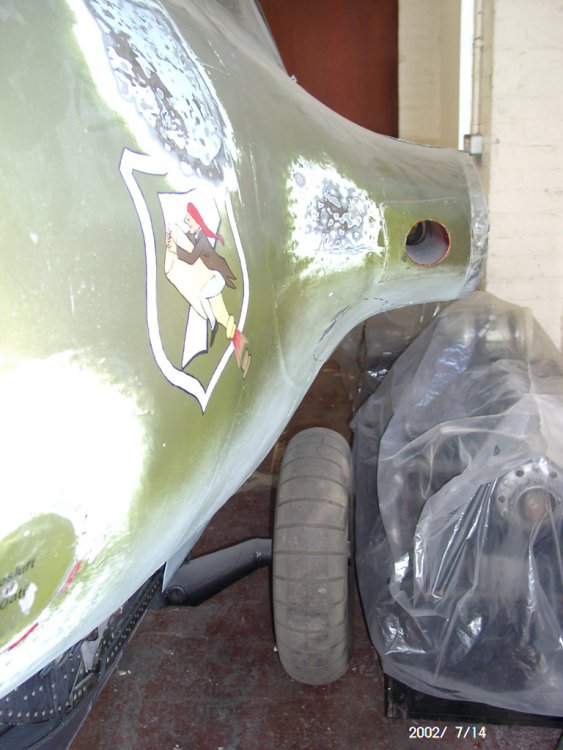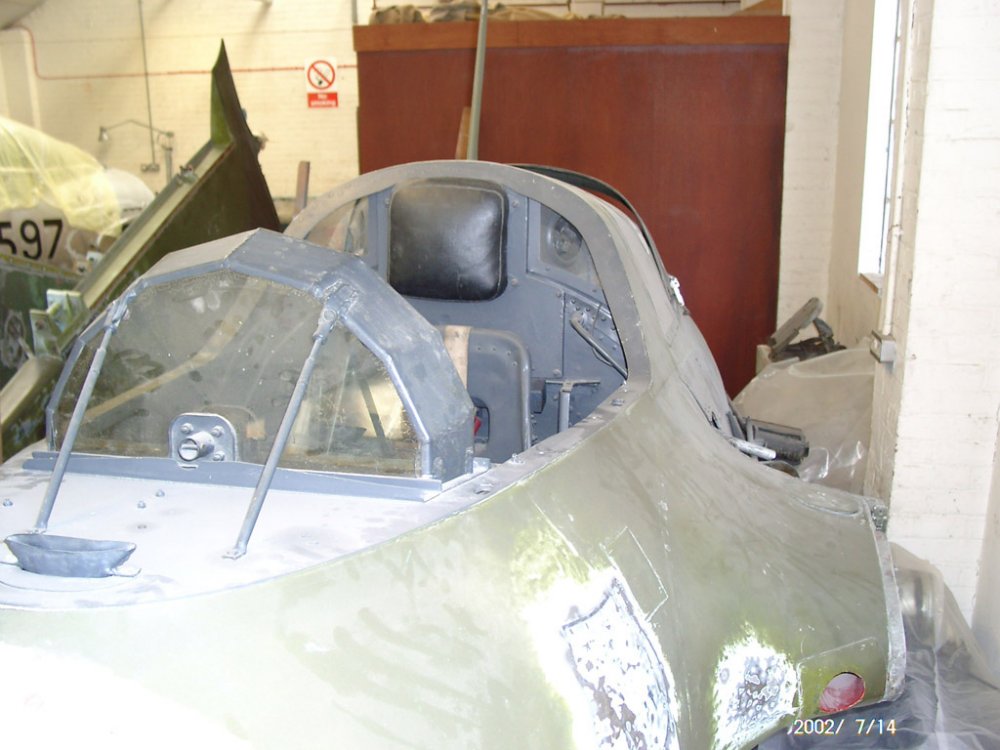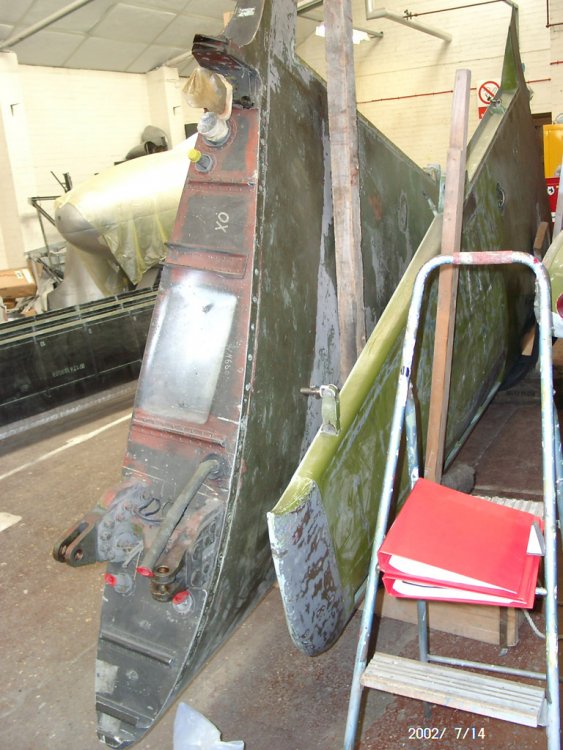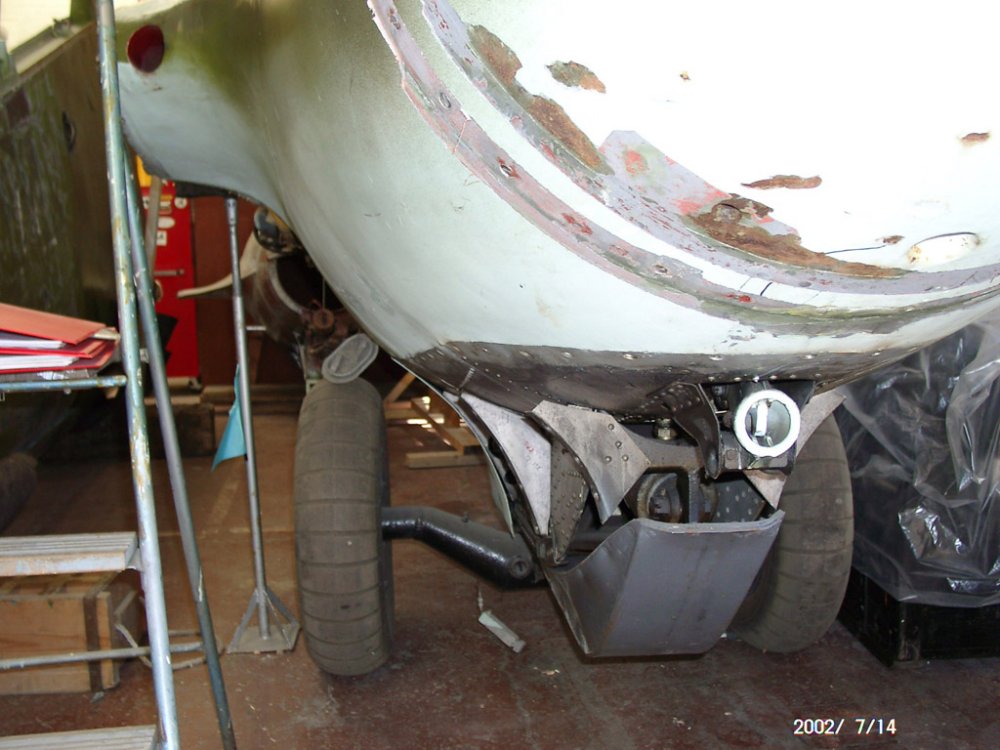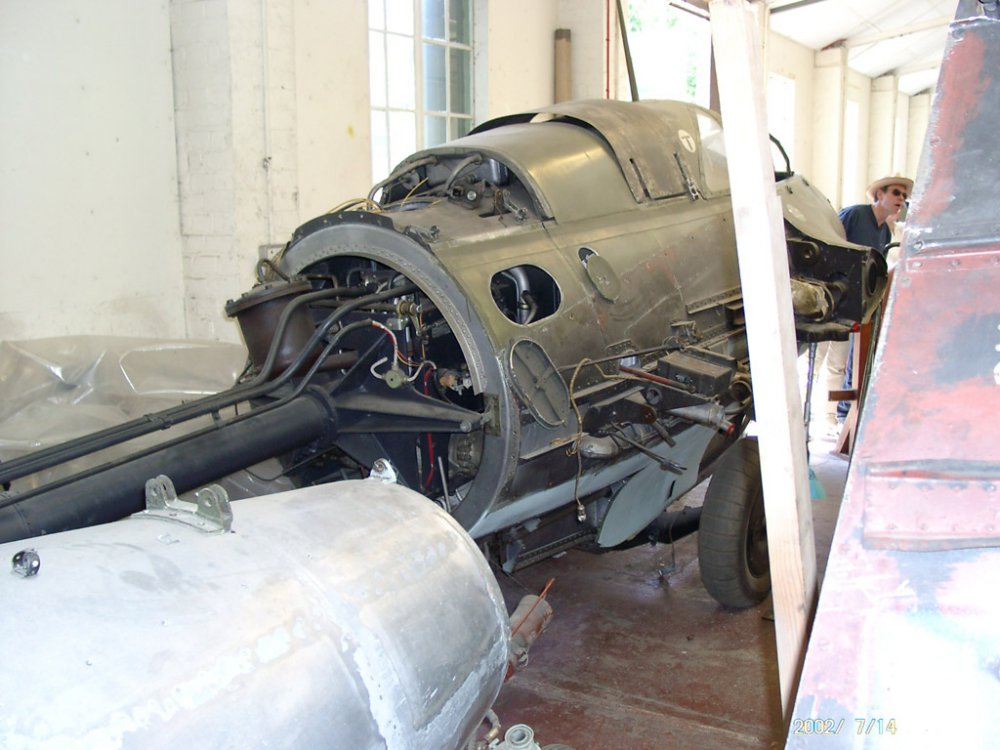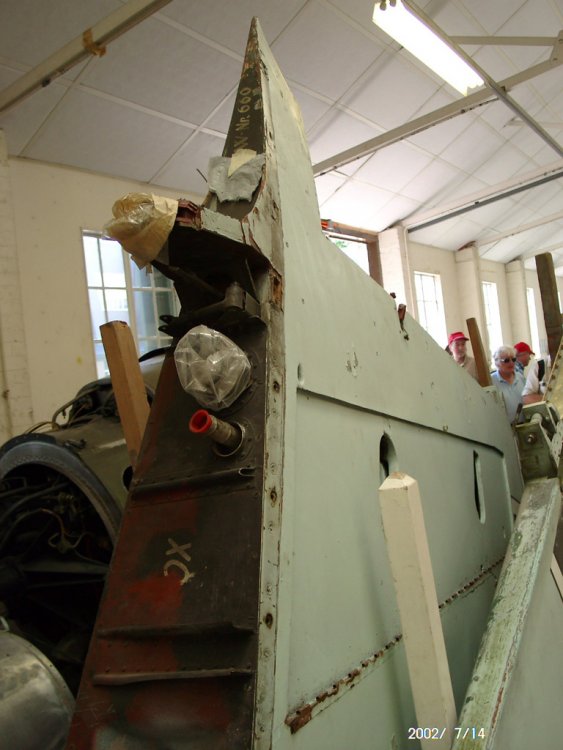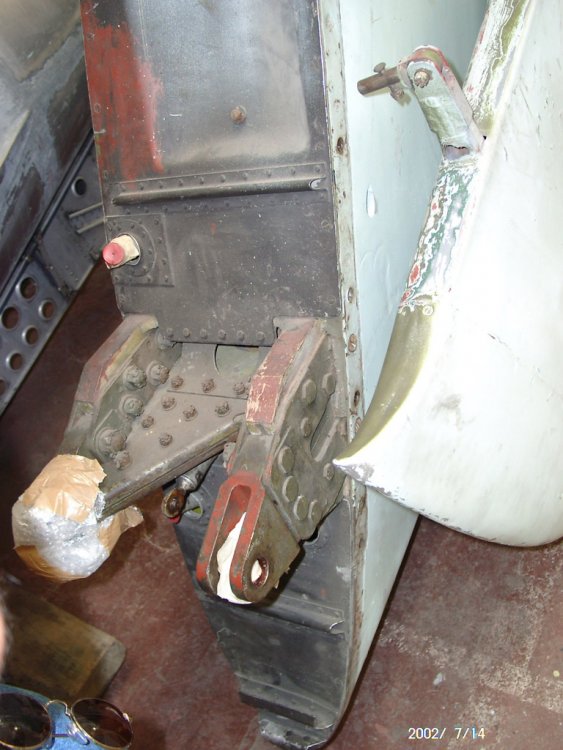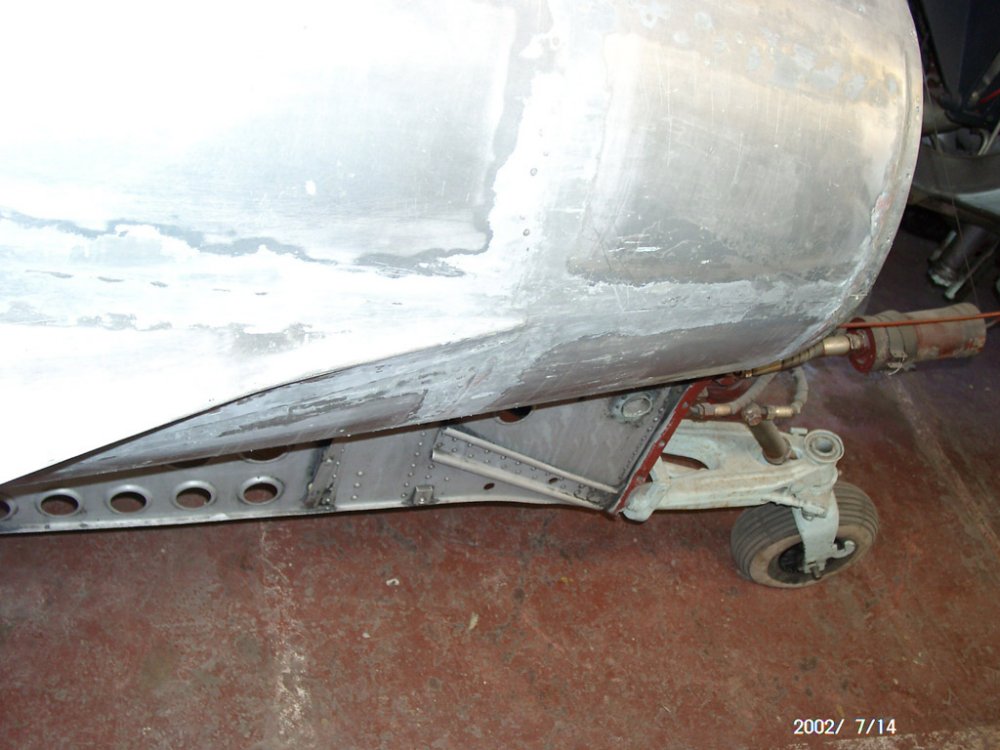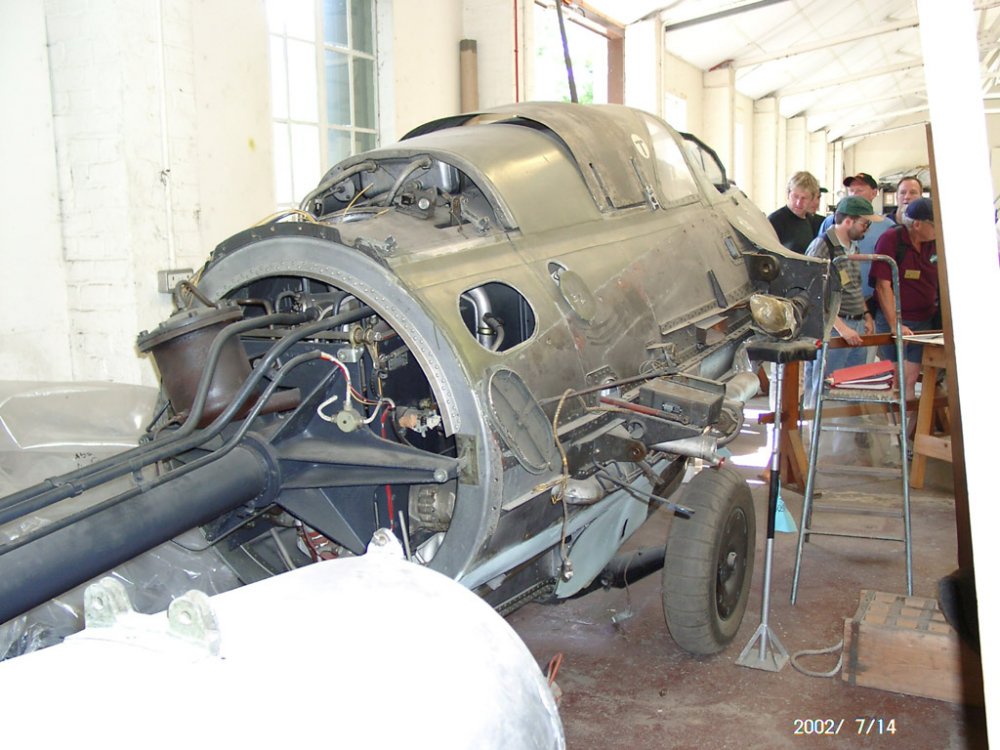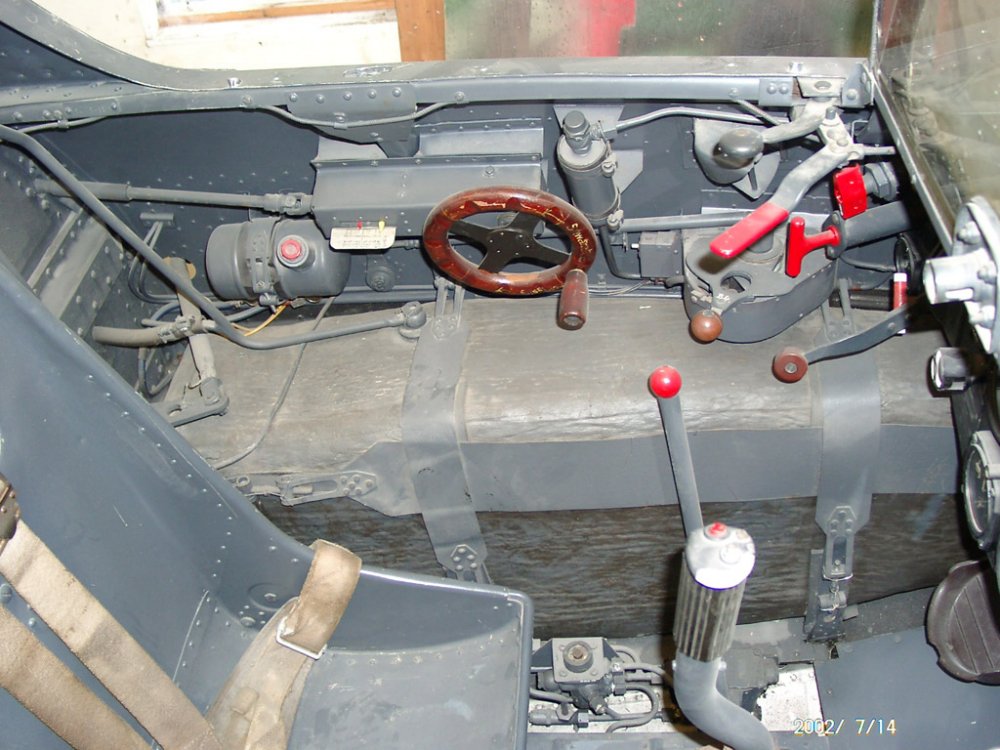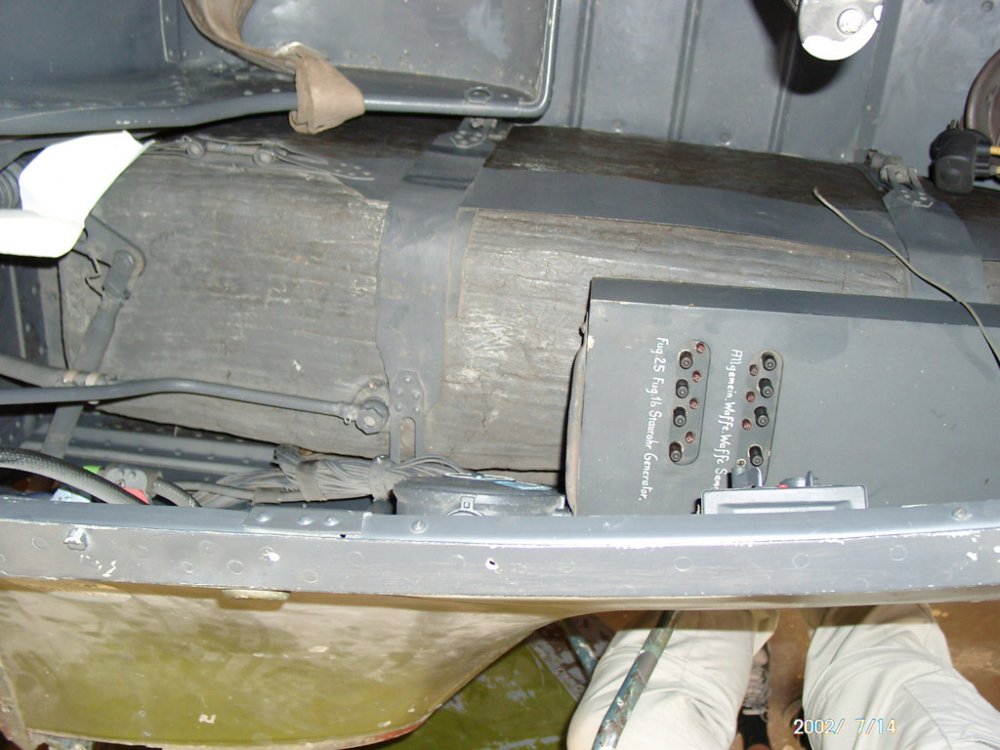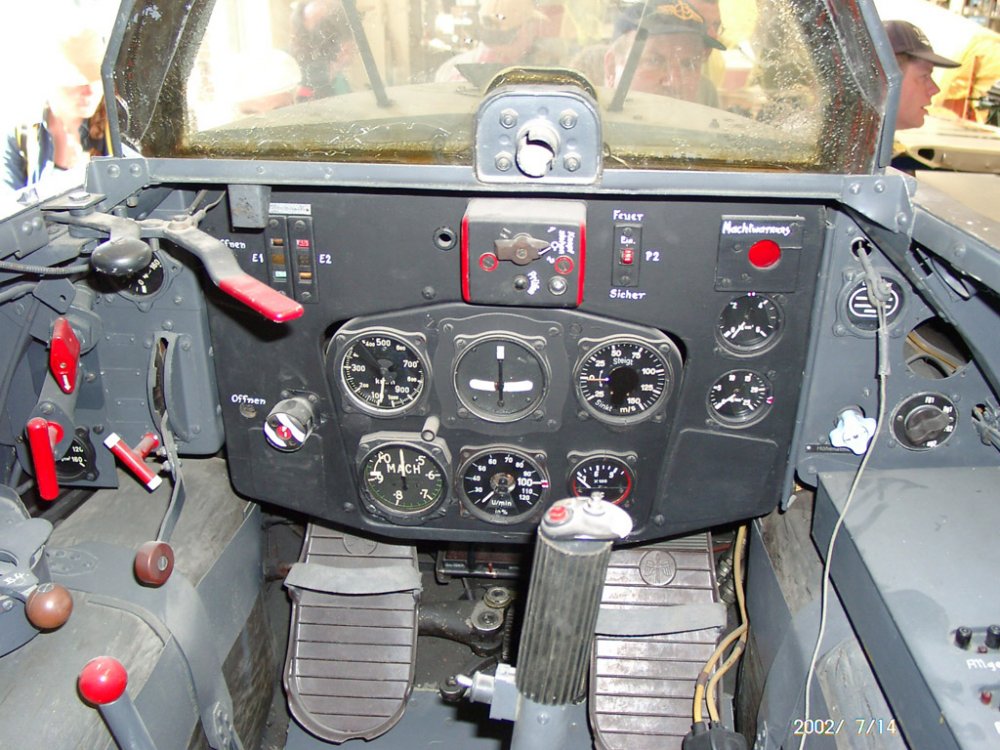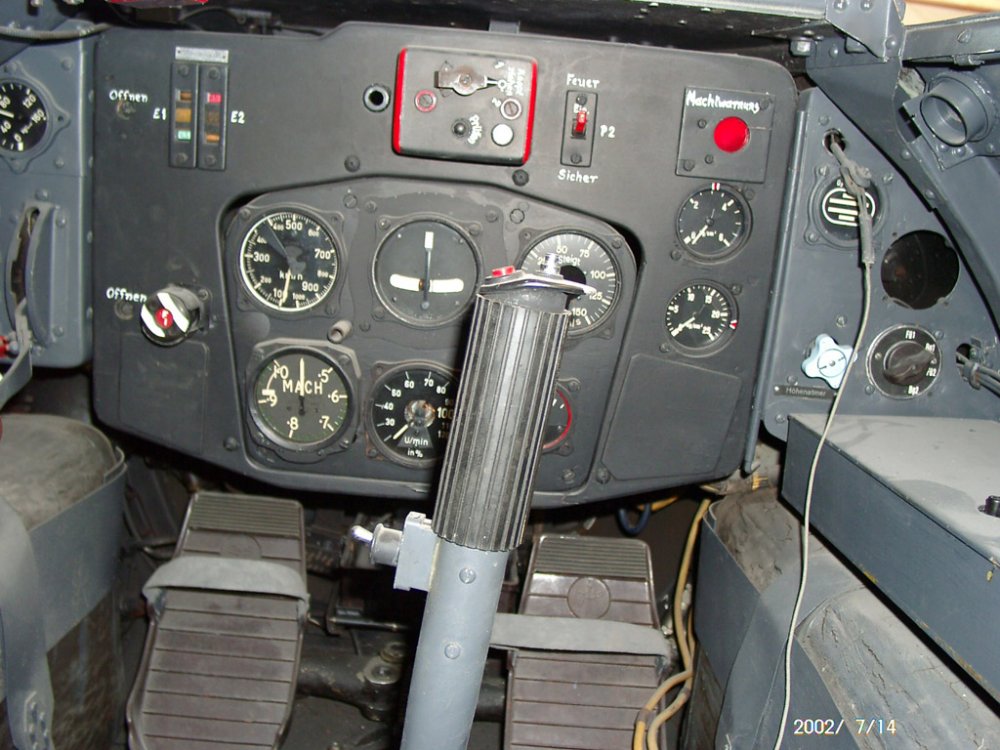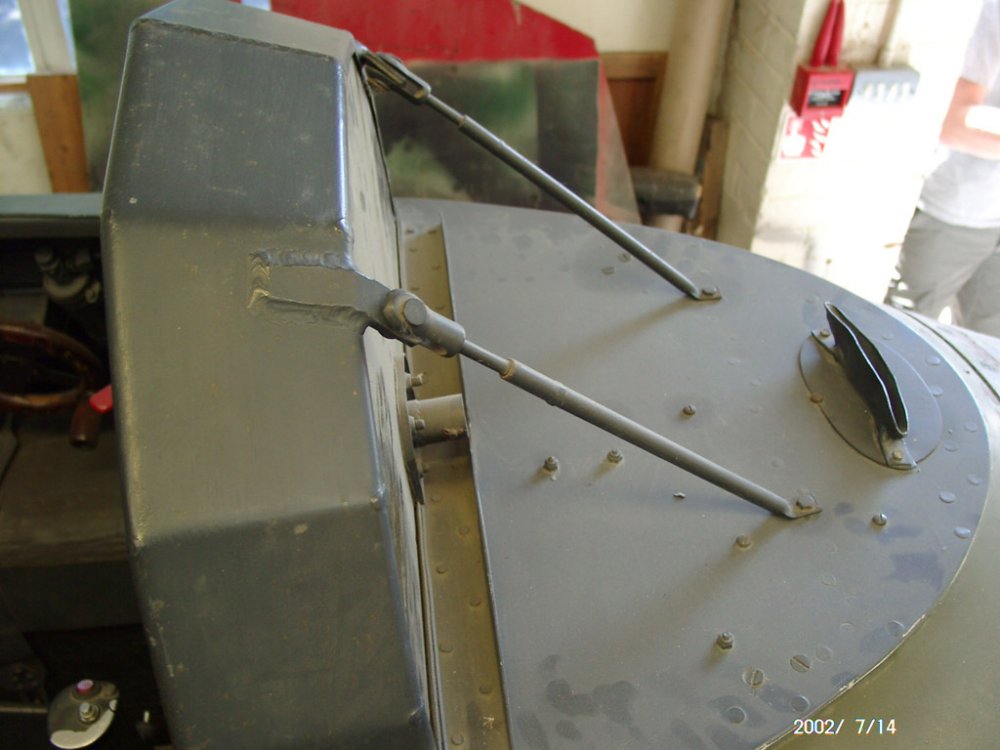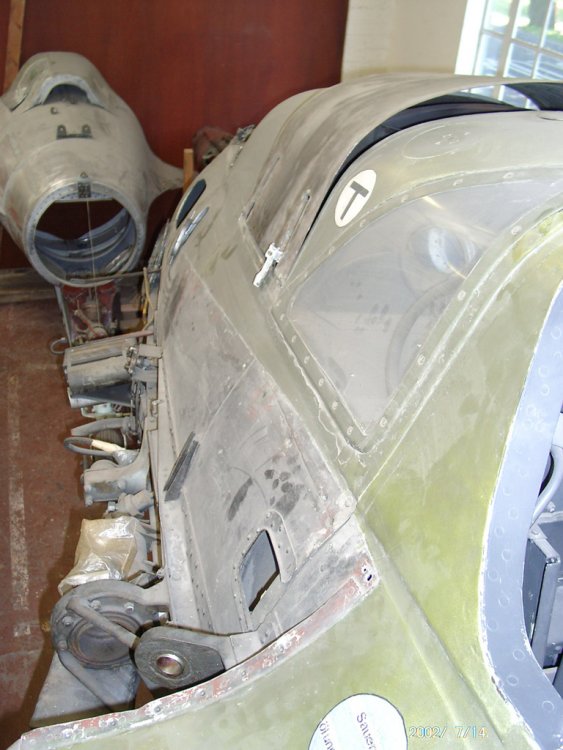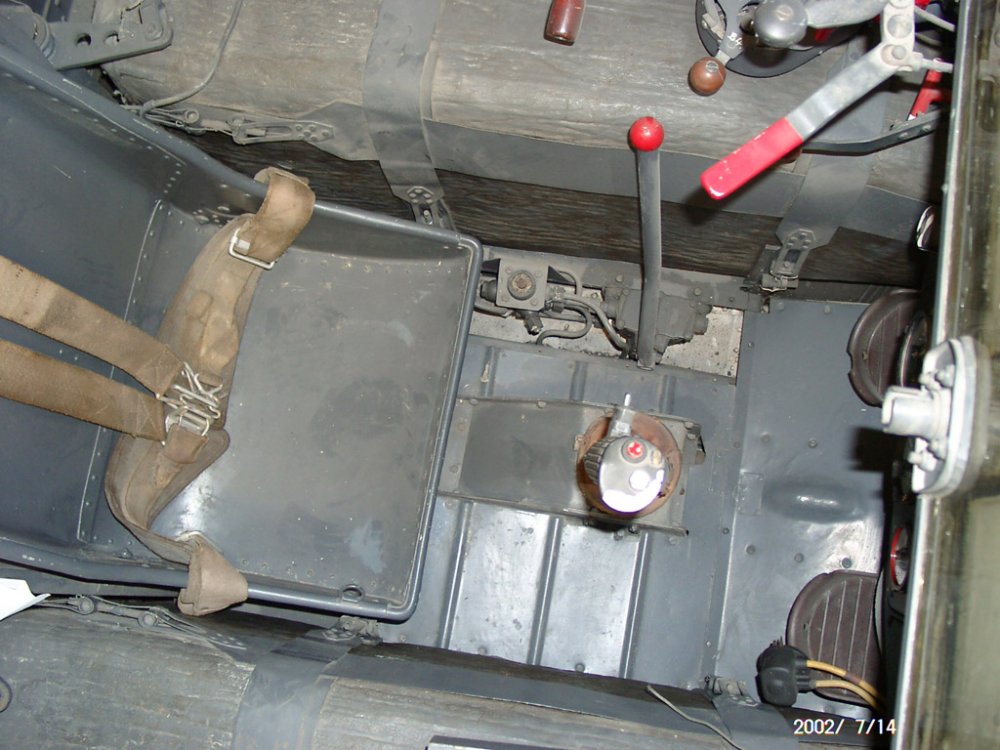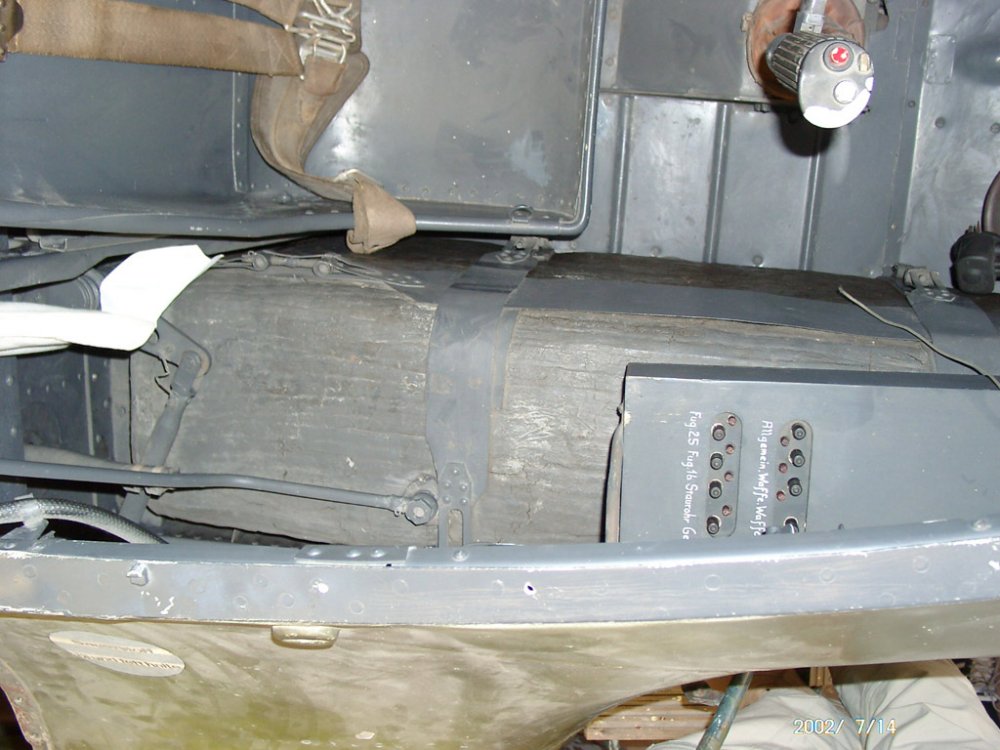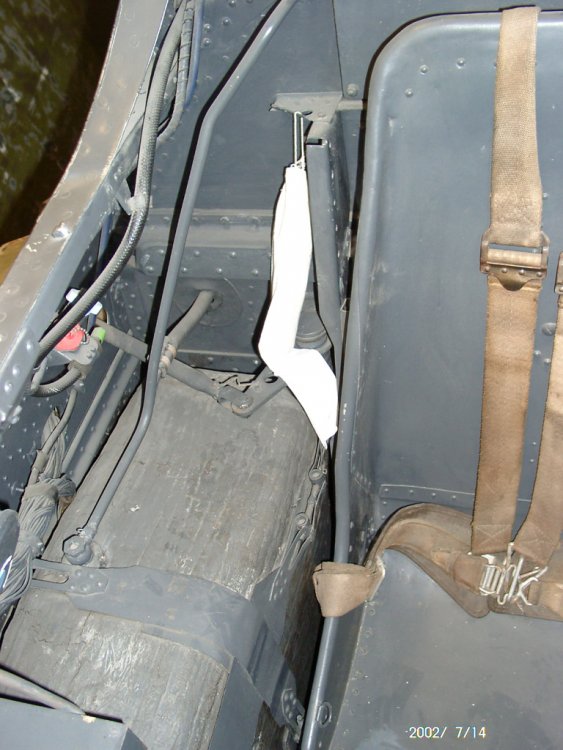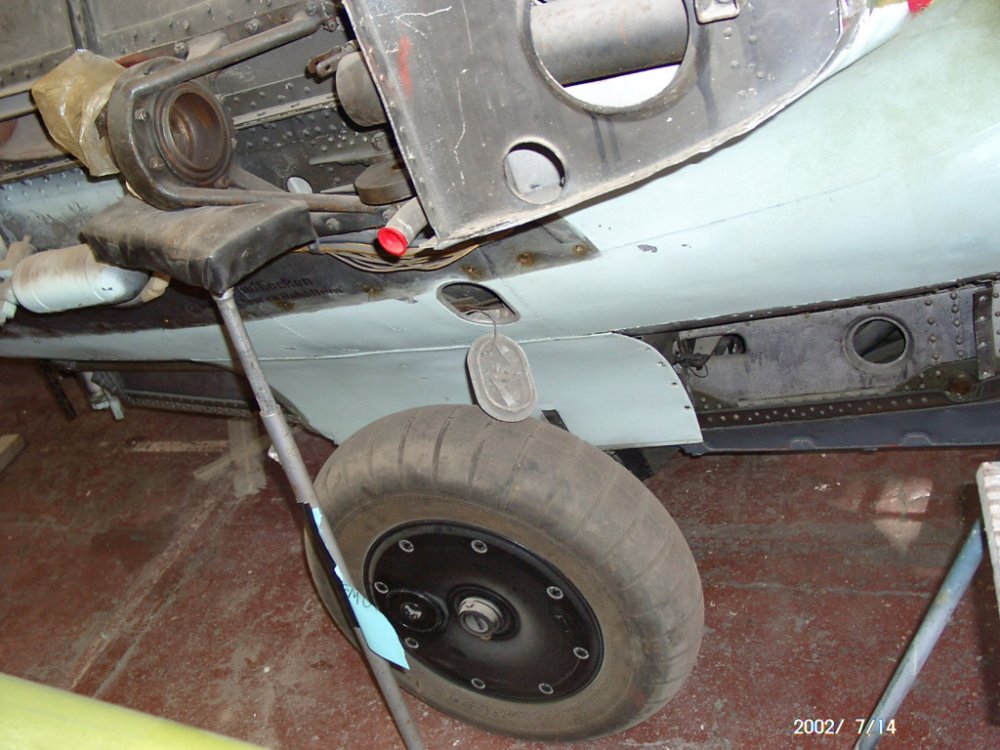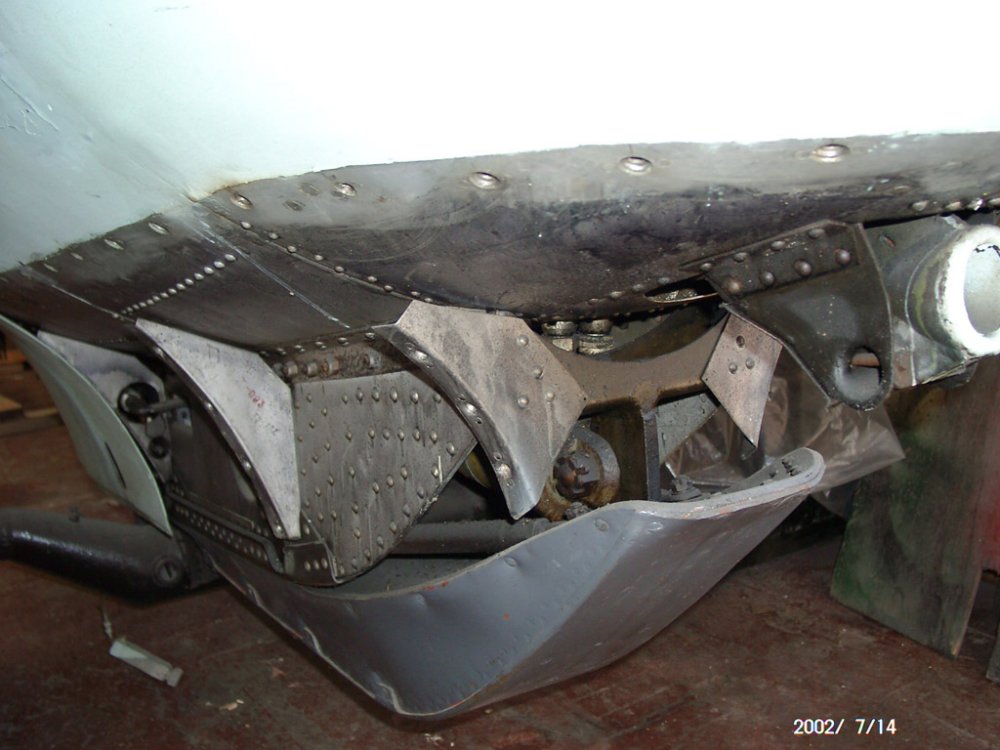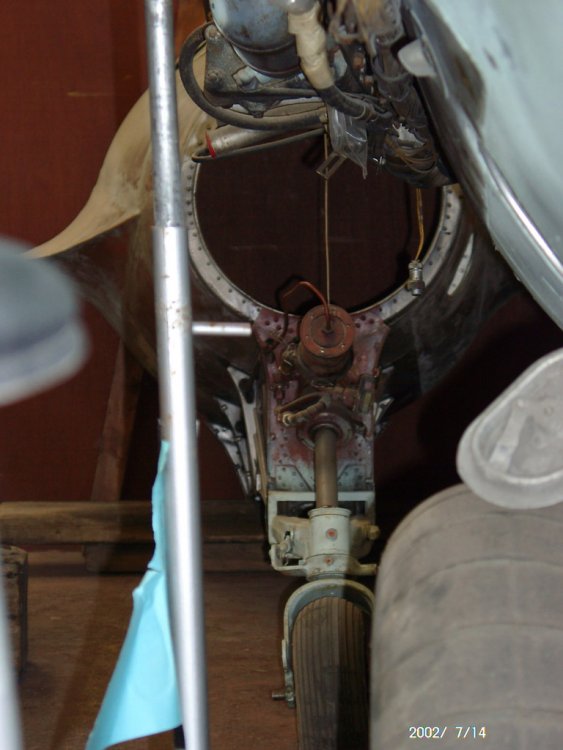-
Posts
3,257 -
Joined
-
Last visited
Content Type
Profiles
Forums
Events
Gallery
Everything posted by James H
-
Manchester Museum of Science & Industry RAF Cosford Day out in York
-

HK Models 1/32 Mosquito B Mk.IV
James H replied to JeroenPeters's topic in LSM 1/32 and Larger Aircraft Ready for Inspection
Just amazing! So pleased that this came out so well, and only a test shot too..... I suppose I'd better bung you another Mossie then? -
Probably the best ever walk-around images of the Me 163 Komet, as taken by Thomas Mayer, Duxford, 2002. Time to dig the Meng kit from your stash. Enjoy!
-
YES!!! Thanks for restarting this one. Maybe it'll give Dave Johnson a kick up the arse to start his.
-

HK Models 1/32 HK Models Mosquito B Mk.IV
James H replied to JeroenPeters's topic in LSM 1/35 and Larger Work In Progress
Is it finished Jeroen? Is it? Is it? -
Many forum memberships vs participation is at odds. I've been told that active members vs statistics can be as little as 12%, but typically between 15% and 20%. I don't think we're doing too bad, plus it's the community that matters, not statistics. We don't go chasing them, and are happy with progression.
-
It's been a long, hard slog, but we have a nice little community here. Great to have you all with us, participating and building.
-
1:32 Fokker Eindecker wing conversion set For Wingnut Wings E.II/E.III/E.IV kits RB Productions Catalogue # RB-P32032 Available from RB Productions for €55,01 World War 1 modellers spend so much time creating painting and finishing effects that make their plastic creations look like fabric covered, timber airframes. But, what if you actually wanted to show those interior structures for real? What if you wanted to build a skeletal or semi-skeletal version of your subject? What if you wanted to create a diorama of a crashed or damaged aircraft? I’m sure we’ve all thought of the possibilities, but unless you’re endowed with amazing talents and plenty of time, it’s pretty much beyond the scope of most modellers. Well, RB Productions must’ve been thinking along those lines, and have now released a set for the WNW Fokker Eindecker kits; specifically for the E.II/E.III and E.IV releases. E.I machines had a shorter span and aren’t compatible. This set is erroneously called a ‘wing conversion set’, where to most accurately name it, I’d call it a ‘skeletal wing replacement set’, as nothing is actually converted. It simply replaces the plastic wings, tail plane and rudder with photo-etch ribs, spars and cap strips etc. This would be ideal for showing the model in a factory diorama etc. If you want to go further and make a framework fuselage, Radu has included instructions for you to be able to do that too. However, that isn’t the actual remit of this kit, so let’s look further. RB Productions’ Eindecker wing conversion set is packed into a sturdy but very shallow corrugated box, with a CAD render image of the completed parts on the lid. Inside, several folds of bubble-wrap cover two small zip-lock bags, each containing a single PE fret. Underneath this is a piece of thick black paper that covers a large zip-lock wallet in which there is the main PE fret and a card stiffener that has a copy of the box artwork printed on it, and TWO download links. One of these is for the PDF instruction manual, and the other is a reference PDF with many colour photos of an actual Eindecker airframe. Very useful indeed! Lastly, two lengths of plastic rod are included, of different diameters. This is quite an unusual review simply because of the nature of the product, but I’ll certainly try. WINGS Every constructional element of the Eindecker wing has been meticulously recreated here. Construction starts with the front and back spars, and as PE is of a certain thickness, the spars will be made from photo-etch laminations. To help you get everything in the correct position, some PE ‘keys’ have been supplied. Slow cure glue is also suggested for this construction, and the use of clamps to keep things together along the length of the parts. Getting this right is imperative. To hide those laminations, cap strips are added to the spars, and all parts are numbered directly, so you can’t get them mixed up once removed from the fret. Ribs are provided as three parts; leading edge, main, trailing edge, and of course, these accurately represent the structures of the real thing, or this would be a pointless task! All rib parts interlock at the spars, creating a solid joint whose parts are correctly placed. Remember to occasionally lay the structure flat to ensure that you don’t in-build any warp. This can still be tested flat, despite the wing having an under-camber. Onto the wing, you will now add some fitments, such as rigging points, tread-plates, internal/wing-warping wires and bracing turnbuckles, compass, gimbal and housing, and anchor points and plates for the wing warp mechanism. You will need short lengths of the styrene rod that is included in this set too. To help define the various constructional elements within the wing, the instructions use colour ink on the CAD drawings, making everything plainly obvious. Whilst the wings look terribly complex structures, this set has been engineered and explained so as it won’t cause the modeller any headache. TAILPLANE & RUDDER Construction of these is again faithful to the original machine, with the separate ribs hugging the main spar/tail post items. The ribs are made as single pieces, whereas they would have been upper and lower elements on the real machine. The overall appearance will look no different though. Those spars will be made from the styrene rod that is included. If I’m honest, I would prefer a length of brass tube here, but I’m sure this solution will work just fine. As per the original, you will need to fit control cable horns, and other associated fitment hardware from the PE sheets. FUSELAGE This set is designed to be fitted to the Wingnut Wings fuselage, but if you actually want to have a totally skeletal machine, then drawings are supplied of the fuselage frames, and how to cut the kit fuselage so that you can graft it onto the forward section of the plastic fuselage parts. This would look incredible, and I think this set really deserves that level of attention in order to get the very best from it. You will need to reference the internal bracing etc. so that you get this as accurate as possible. INSTRUCTIONS/REFERENCE The instructions are a joy to read, and totally comprehensible, despite the complexity of the structure. I don’t feel that anything here will be difficult to build. Now, an important mention is made of priming the parts before assembly, due to their fragility etc. It is also suggested that you use an adhesive such as Gator Glue etc. The reason for this is because the wing and tail structures could flex slightly due to weight etc. This would cause CA glue to crack. Another option is to solder the parts, if you have those skills. I’m a big fan of the reference material supplied here too. This contains not only further links to online reference, but also a suite of superb colour photos of a surviving Eindecker, with great reference showing the internal inter-rib tapes etc. Conclusion Certainly one of the most original and innovative PE sets I’ve seen in a long while, and one that I’ve always dreamed of eventually seeing. Radu’s design and production are excellent, and whilst not a cheap set, the cost probably doesn’t even reflect the actual work that’s gone into designing this excellent release. All you need is a Wingnut Wings E.II, E.III, or E.IV, and you’re ready to go! Very highly recommended My sincere thanks to RB Productions for sending over this review sample. To purchase directly, click THIS link.
-

Trumpeter 1:35 German Armoured Train PanzerTriebwagen Nr.16
James H posted a topic in Armour/AFV Reviews
1:35 German Armoured Train PanzerTriebwagen Nr.16 Trumpeter Catalogue # 00223 The Panzertriebwagen No. 16 (Skr. PzTrWg 16 or PT 16) was a German heavy armoured train, powered by a Voith 550hp hydraulic transmission diesel engine, and built by the Berliner Maschinenbau-Gesellschaft Actien vormals L. Schwartzkopff, in 1942. This vehicle was based on a locomotive design for an armoured train (WR 550 D14), and then encased in further armour and equipped with two armoured artillery positions, at both ends of the train. These were initially armed with two 20 mm anti-aircraft guns (2 cm Flakvierling 38) but this was modified to use two Russian 76.2 mm FK 295/1 cannon (as used on the BP42 armoured trains). The thickness of the armor Panzertriebwagen No. 16 ranged from 31mm to 84 mm, and the vehicle was the heaviest armoured rail vehicle in existence. Only one was built, and this served on the Eastern Front. By 1943, the train was used as a reserve weapon, patrolling areas that were threatened by partisans. In the spring and summer of 1944, it was in the service of the Army Group Centre, and participated in, amongst others, in the battles of Rawa Ruska and Lublin. It was then withdrawn westwards after the Eastern Front started slipping towards the borders of the Third Reich. In April 1945, PzTrWg 16 took part in the battle of Neuruppin, and between the 1-2 May 1945, was captured undamaged in Neustadt. After the end of World War II, PzTrWg 16 was pressed into service with the Polish Army, maintaining operational military communications in the areas of service. The train was on operational service in the Bieszczady Mountains, up until the end of 1947, protecting railway routes and election posts against partisans, during the referendum on the 30 June 1946. The same operations were conducted for the elections for the Polish Sejm parliament, on January 19, 1947. Trumpeter certainly like to release some oddball kits, and this is definitely one of them. It’s also an imposing box, being quite large and certainly pretty heavy too. I have quite a liking for Trump’s box artwork, and this one depicts PzTrWg 16 sat stationary, presumably somewhere near the Eastern Front, with a German officer and soldier looking on. It’s quite an understated image, but one that demonstrates the sheer size and power of this train, and its relative featureless façade, save for the armoured turrets at each end. This will certainly be an interesting and leftfield subject to tackle. Opening the lid immediately shows the reason why this box weighs so much. It is absolutely stuffed to the rafters with styrene. Some of these parts are impressive in their size too. This behemoth of a kit contains: 19 sprues, moulded in light grey styrene 6 large, individual styrene parts for train sections such as cab, chassis and turrets. 8 large styrene parts for the roadbed 1 clear sprue 510 plastic parts 3 Photo Etch frets with a total of 204 parts The box itself has a single narrow compartment set aside into which the large hull and chassis are located. You will also find the clear sprue and PE frets here too. All plastic parts are bagged too, with the cassis sat into the bottom of the cab. The remainder of sprues in the box are mostly packed in twos, but there is no need to worry about possible damage, as all is superbly packed. UPPER HULL & CHASSIS Well, I really couldn’t ignore these parts for my first look at this kit. The hull itself is the section that contains the diesel powered loco, all hidden in a seriously robust looking exterior. To give you an impression of size, this part is almost a couple of inches longer than a foot (around 340mm), and is as tall as it is wide (approx. 95mm). This impressive feat of engineering must’ve employed some sort of slide-mould technology due to the various slots, openings and other minor external detail. The top of this clearly shows the riveted armour plating, ventilation louvres/punched panels, cover plates, and some very impressive weld seams around the forward and rear crew entry cupola points. The upper centre section is a separate piece, presumably as this is where the injection moulding point was. Small traces of sprue gate can be seen here and just need to be removed. For clean up, that’s all that’s required on this part. More neat weld seam detail can be seen around the fore and aft ends of the hull. Internally, there is no detail, but there doesn’t need to be. There are some stiffening ribs that run top to bottom along the inside walls. These help give the chassis something to sit against so that that part remains straight. That chassis is pretty featureless, simply being a floor for the hull. Onto this will fit the wheels and running gear parts. A large hollow centre will accommodate a disc that acts as a securing point for the train gear below. Again, I think this is moulded separately as it was originally the point where the plastic was injected. ARMOURED TRUCK/PLATFORM There is a turreted and armoured truck at each end of the train, and as a result, you will need to make two identical assemblies for these. There are zero differences between the two. The largest parts here are the truck base and the plastform that sits atop them (mounting the turret). Each of these two parts (4 in all) is separately bagged and requires virtually no clean up at all. Very impressive. Detail is necessarily sparse, but contains bold raised rivets, weld seams, hook and anchor points for the main hull, and slots/holes for minor external detail. ROADBED & SPRUE L TRACKS This, when assembled, is around a metre long, with the model itself measuring approximately 630mm. This would give you some space for any further display items, or maybe you could shorten the track accordingly. The track consists of four different sections, with two of each included. In the manual, these are referred to as ROAD A, B, C and D, and construction is very straightforward as they have interlocking lugs. Test fitting them does show that the side faces will need some filler and sanding to remove joints, but the ballast surface detail is more than passable, with the joints hiding reasonably well amongst the detail. Note the hollow slots. This is where the sleepers fit from below, moulded as sections. Onto this will fit the tracks and other minor, associated parts. Two identical sprue ‘L’ runners are included for the roadbed, and these are packed with protective foam in between them. This protects the fragile cleats what sit on top of the sleeper sections. These are designed so that the track actually threads down the sections. A simple but effective wood grain finish is applied to the sleepers, but perhaps the edges are just too perfect. A little nibbing here and there will improve their look. The tracks themselves look very good, but thee are some ejector pin marks running along the inside edge of them. These can be effectively hidden by ensuring that these face inwards, away from view. Lastly, the track joint plates are included here, incorporating both bolt head and threaded end/nut detail, just to break things up a little. That’s a nice touch. SPRUE A The parts here are pretty obvious, with the hull upper centre section and the lower chassis central disc being included. Parts are also included for the hulls lower running gear framework. These will be further supplemented by further sprue additions. As will most main parts on this model, detail is sparse but accurate, with large studded rivets and bolt heads being the only real order of the day on the side parts. SPRUE B (x4) We now start to see parts which tell you that this is actually a train. These sprues contain all of the wheels for this subject, plus chassis spacers, leaf spring suspension parts, wheel fixing caps and bearing housings etc. You’ll also notice parts for the train lamp bodies too, as well as footplates, handles etc. SPRUE C (x2) There are quite a number of detail parts included here. These include buffers, globe buffers, footplates/stanchions, brackets, hydraulic hoses, tow lugs, grab rails, rear platform access protective armour etc. The access doors are also moulded separately and can be posed either open or closed. However, if you want them open, you’ll have to fabricate the internal detail yourself, as none is included. A strange option by Trumpeter, and one that will only be useful if someone releases a detail set, or you can make the parts yourself. SPRUE E (x2) Both of these sprues contain parts for the turrets, exclusively. The main turret is moulded with alternative side plates as separate parts. There are 10 sides to each turret. These are quite plain looking, with only an opening in the upper face for crew entry. The reason for the separate plates is that each of these has raised detail. It would’ve been a nightmare to mould them integrally. Also present here are parts for the guns and the large turret bases. Each gun has a fabric cover for its mantlet, and these are included as plastic parts, and looking suitably realistic. PLASTIC SUMMARY Apart from the edges that need filling on the track sections, and the pin marks along the inner track lengths, there’s nothing at all to fault here. I can’t see any defects, such as sink marks etc, and moulding is generally very, very good. A little flash here and there is about the worst you can expect to see here. PHOTO ETCH Even though there are over 200 PE parts here, they are quite simple, if not repetitive and fiddly to fit. They mainly consist of small lugs that fit to the outside of the turrets and their carriages, as well as the hull armoured sides and roof. These are mainly carried on a large, single sheet. Two identical, smaller frets are included, with more lugs and parts for turret guns. INSTRUCTIONS These are very typically Trumpeter, with clear line drawings illustrating all construction sequences. Nothing looks very difficult with this model, but there are no colour call-outs for any part. The reason for this is probably because most things were the same colour anywhere (field grey). A colour sheet is included that shows the completed train sat on its track. Conclusion Actually, this is a very nice kit, and would make a welcome change from the usual run of the mill subjects that we all get bogged down with from time to time. It’s also a reasonably priced kit. I’ve seen this for around £75 + P&P from one retailer, and the model itself is pretty large when complete. There’s nothing here to challenge anyone, except for perhaps those PE lugs, but that’s more by necessity than a fault of Trump! Great kit. Strange subject, but with a wow factor when finished! Highly recommended My sincere thanks to Pocketbond for the review sample.- 2 replies
-
- 3
-

-
- Panzertriebwagen
- armoured train
-
(and 1 more)
Tagged with:
-
1:24 Bugatti Model 100 (P100) Record Plane Fisher Models Catalogue # GA-2401 Available from Fisher Models for $225.00 I’ve often heard it said and read that the Bugatti Model 100 was the aircraft that could’ve won the war in some form or other. Won it for the French against the Germans, and indeed won it for the Germans who would have used a captured design for themselves, against the allies. I don’t really subscribe to either of these arguments. It’s a flight of fantasy. A supposition about an aircraft that not only was designed as a racing aircraft, and indeed had never actually flown anyway, means that any data on performance simply doesn’t exist. The Germans, if having captured the machine after the fall of France, probably wouldn’t have used the machine for anything more than trials. I think it’s fair to say that Germany’s faith in their own technical ability, would have probably taken precedence over a rich man’s toy. Having said that, the design of the Model 100 really shouldn’t be kicked to the kerb. It truly was a revolutionary design, and way ahead of contemporary fighter design. Whether it could’ve been used for Military service is simply a matter of conjecture. Designed by Louis de Monge, Ettore Buggati’s chief designer, the Model 100 was actually powered by TWO Bugatti automotive engines that were fitted into the airframe at slightly opposing angles, driving two contra-rotating propellers. The design also incorporated an inverted V-tail layout that contained the engine’s cooling intakes, as well as a fully retractable undercarriage. Construction was also mainly of timber. This design was so promising that the French approached Bugatti with a proposal to utilise the Model 100 as a fighter aircraft, despite it being designed specifically for the Deutsche de la Meurthe cup race. History had caught up with Bugatti’s Model 100, and the machine wasn’t completed for the designated event, and as Hitler’s troops began their assault on Europe, the Model 100 was safely stashed away before being restored and put on display. The story doesn’t end there though. In fact, it continues today as a team of aero enthusiasts recreate the beautiful and unique lines of the Model 100, with a view to flying this reproduction and putting it through its paces. This model is produced in conjunction with these guys. You really must check out their website here If anyone was to produce a beautiful model kit of this aircraft, then Paul Fisher would be your man. In fact, many years ago, he released this subject in 1:48 scale, and those models not can fetch a pretty penny if found for sale. With Paul’s expertise in mind, he was commissioned to create this new 1:24 kit of what must surely be one of the most aesthetically pleasing machines ever to have not flown! This one comes in quite a large and sturdy corrugated cardboard box, with a top-opening lid. The actual product label is on the side of the box, and looks quite understated. Opening the box up, you see a real hallmark of Fisher’s releases; lots and lots of fine tissue paper. Main components such as the fuselage and wing, are wrapped in tissue, and the various zip-lock bags of smaller parts are tucked within the folds of tissue paper. Full marks for protecting the contents of this kit. Underneath all of the parts is the instruction manual and a small decal sheet for the cockpit instruments. There is no photo-etch required for this kit, as Paul has reproduced all detail in resin. FUSELAGE This part is copiously wrapped in tissue paper, and a quantity is also stuffed into the space between the fuselage walls, to help prevent any squashing inwards at this point. As the model has a fully detailed engine bay, the spine is cast separately, as can be seen here. Another point of note is that the inverted ‘V’ tail is cast in situ. The tail units on the P100 were smoothly faired into the fuselage, so this was simply the best way of ensuring that the clean lines of the Bugatti will translate through to your model kit. Please also note the fin intake vanes alone the leading edge of the tail surfaces, beautifully reproduced here. Being resin, there are some mould paring lines which need to be removed, and these are along the edges of the tail plane, and also on the underside of the nose area. A few swipes with a sanding stick should make those history. Some of the joint edges also want cleaning up, and a little filler where things are slightly jagged. There isn’t too much in the way of detail on the exterior. The P100 was mostly constructed of wood, and this was sanded smooth, sealed and filled etc, before being painted. Notice that there are two exhaust manifold fairings on the exterior; one for each of the two engines. There is some internal cockpit detail though, including floor and sidewall wiring and cast positions where the numerous cockpit internals will be placed. All elements within here are sharp and have excellent definition. WING This is an impressive, heavy, single piece casting that really has to be seen to gauge just how good it is. Externally, you will find no rivets etc. due to the Bugatti’s timber construction, but you will see some beautifully scribed panel lines, fabric tapes on the elevators, sharply defined louvres on the rear wing root, and nicely shaped wheel wells. The latter don’t contain any detail, with only minor detail being included during assembly, such as the strut pivot mounting plates. What detail there is, however, has been superbly executed by Paul Fisher, with the same attention to detail that we have come to expect from his work. It’s safe to say that the Bugatti’s slightly forward-swept wing form is perfectly captured here, along with the thin-edged wing root that mates up perfectly to the fuselage. Before the wing can be attached to the aircraft, you’ll have to assemble and fit an incredible amount of detail on the centre section. Here, both engines and associated hardware will be installed. Just make sure you follow the instructions carefully, and if in doubt, temporarily fit the fuselage to make certain that those parts will be properly encompassed within the sleek design. OTHER COMPONENTS Scattered around the various folds of protective tissue paper are another SIX bags of resin parts. I don’t think there’s strictly any rationale for what parts are bagged together, in the main, but these is a loose relation in some bags, such as main gear doors, wheels and struts etc. also packed in with the two contra-rotating propellers. One of these props is badly curled at the tip, but a dip is very hot water will fix that immediately as there is no physical damage. Let’s take a look at what these parts are, and there place in the bigger scheme of things, along with some photos to give you an idea of the detail that is present here. WALLET 1 As already mentioned, here you will find the main undercarriage struts, wheels, hubs etc. Note that the struts don’t actually have any reinforcement wire in them, but I’m very confident that if it’s not included here, then Paul knows it’s not needed. Strut detail is very simple, as per the real thing. I’m not sure whether you might need to add a hydraulic line to these, so check any reference you may have, with the Bugatti Project pages being probably the best reference you can access. The hubs fit neatly into the wheels, and then the cast lugs sit inside the strut forks. There is a little clean up to do on some parts, such as the paring line from the mould, seen along the outside of the wheels. As the wheels are tread-less, this is an easy task to accomplish. The main gear bay doors are cast as single pieces, complete with their folded appearance. Note also the small retraction arms in this packet too. Propellers are cast integrally to their spinner parts, and putting these together shows that they match perfectly. The edges of the prop blades are nice and thin too, and minimal clean-up will be required. WALLET 2 Quite a number of cockpit parts here, such as those sidewall consoles through which run the two power transmission shafts from the engines to the propellers. Sitting these inside the cockpit illustrates a perfect fit. For such a small, narrow cockpit, the Bugatti was picked with enough detail to more than satisfy the modeller. Take a look at the parts here, and you’ll see bulkheads, gearbox/prop-shaft unit, transverse plate with fairing and instrument detail, instrument panel that fits to the transverse plate, casting blocks with throttle details, levers, instruments etc., two part seat that’s very reminiscent of those seen in modern gliders, and lastly, two compressed air bottles that sit either side of the sleeved prop shafts in the forward fuse. I’m very impressed with the instrument panels. The instrument fascias are bold, and also blank, to accommodate instrument decals that are included. At the rear of the panels, the instrument bodies can be seen. Again, a little wiring here should be all that’s required. Don’t think that any of this detail is wasted either, as the Bugatti has an impressive canopy that will show everything you include. WALLET 3 We venture into the rear engine compartment now, with a number of associated parts. These include forward and aft magnetos, oil pump/shaft, equipment mounting platform, radiator, air ducting unit, coils, oil tank, header tank, and casting blocks containing numerous timing gears….all of course essential for a high performance racing aircraft. Many parts here are either lugged or tabbed for precision assembly, and as before, the detail is just incredible. You really won’t want to glue the spine over this area when completed, and nor should you! WALLETS 4 & 5 These are pretty similar in content and almost identical in remit. They both concern the dual engine installations. The lower crankcase of each engine is buried deep within the fuselage, and simply won’t be seen. Paul has used this for his benefit by making that lower area a block that plugs into the wing centre area, onto which the rest of the engine is built. These packets contain cylinder head blocks, crankcases, intake and exhaust manifolds, a strip of spark plugs, blower and drive unit, camshaft drive, and water cooling piping. Despite the apparent complexity of the finished arrangement, this actually looks quite simple to assemble and should cause zero problems….as long as you have patience for those spark plugs! Some wiring is all that’s required here. WALLET 6 The last packet contains the spine, complete with vents and intakes, plus a gorgeous clear resin canopy that’s wrapped up in tissue paper. Clarity is extremely good, and framing detail means that this should be easy to mask and spray. There’s also a small decal sheet for the instruments, designed by Airscale and printed by Fantasy Printshop, so quality really is assured. INSTRUCTIONS Fisher’s instructions are driven by their photographic illustrations, depicted in black and white, but with descriptive text that helps you with every single area of construction. As this model is very intuitive with regards to design, many components are quite obvious when it comes to their location. Simple colour notes are given on the front page, but there is some confusion as to the interior colours as these no longer exist on the original. Suggestions are given, as well as for external colours and the use of Bugatti motorcar reference for the engine bay. Conclusion This is an absolute STONKING release from Fisher Models, and depicts this iconic aircraft in its most beautiful form, complete with an amazing interior. Remember, this is also a 1:24 model, despite the model’s wingspan of around 1ft. This means it should also fit comfortably in your display cabinet too as it’s around the same size as a 1:32 single seat fighter. Production quality is first rate. If anyone knows how to master and produce a whole resin model, it’s Paul Fisher. This isn’t a cheap model, relatively speaking, but is still very good value for money when you consider the subject and amount of resin included. It’s also a real showstopper, in terms of style and execution. This will soon be rolling from my workshop, but finished in bare wood and metal, and not the racing blue you would expect. I just hope it turns out well. If not, it was Paul’s suggestion!! If you are keen on this kit, remember that there are only to be 200 made!! VERY highly recommended! My sincere thanks to Paul Fisher of Fisher Models for this review sample and build opportunity. To purchase directly, click THIS link.
-
Thanks for that info. VERY useful!!
-
1:32 Junkers Ju 87G-2 Stuka Trumpeter Catalogue # 03218 Available from Hannants for £52.99 The Stuka is hardly an unknown amongst us modellers, and until recently, we only had the Revell/Hasegawa kits to choose from in 1:32, with the exception of the not-so-easy-to-source Ju 87B/R from 21st Century Toys. If you wanted to build the later, and sexier looking Gustav, then it was the Hasegawa and Revell (ex-Hasegawa) that were the order of the day. However, over the last three years, Trumpeter have stepped up to the plate and have released a whole range of Stuka versions, including the more unusual ‘Anton’, and also a skis-fitted machine. After a little extra parts tooling and re-jigging, the latest incarnation of this sees the only alternative ‘Gustav’ to the Hasegawa/Revell release, and of course offers a fully detailed engine, unlike the other releases. Let’s take a look under the hood of this one and see what exactly we get. https://www.youtube.com/watch?v=aTS686z0Cbo This kit is packed into one of the rather sturdy and typical Trumpeter boxes that is constructed from corrugated card, and has a high gloss finish. I’ve always quite liked Trumpeter’s artworks, and this is no different, capturing the lines of the Ju 87G over a winter landscape. Lifting the lid shows a compartmented interior, with a number of smaller weapons sprues, vinyl tires and two small PE frets packed into there. The larger compartment of course holds the main part of the kit, instructions, a glossy colour scheme sheet, and a single decal sheet. There are a total of FOURTEEN sprues of light grey plastic here, that are mostly packed separately, plus another two clear sprues that are again separate, and also protected further by being wrapped in thin foam. SPRUES A & P The unusual nomenclature here obviously shows that earlier alphabet labels applied to the previous releases in the Stuka range. Both of these sprues though, are mainly concerned with the outer wing panels and other wing elements. Those main, outer wing panels are connected to their inboard counterparts by means of two spars that not only create some extra rigidity, but also ensure the correct angle is attained. External wing panel detail is excellent, with rivet and fastener detail only along the main panel lines. The various ports are neatly scribed too and look very good. Note that the wingtips are separate parts, presumably indicating a later release of the extended-wing D-5 version. Seems pretty logical to me. Both gun bays are moulded so they can display the weaponry within. Those gun bays are also more than reasonable for an out of box experience. They comprise of a detailed floor with stringer detail, separate sidewall parts, MG17 gun breeches, breech plates, ammunition feeds and stub barrels. Inboard upper wing panels have the characteristic stiffening strakes on their exterior too. Please note that to fit the external gun pods, you will need to open up a series of predetermined holes within the inside of the lower wing panels. Other parts on these sprues include the stabiliser struts, main wing spars, wingtips, and inner and outer flaps. SPRUEs C1 & C3 These two sprues are physically connected and concern the Jumo 211 engine. Together, they contain over 30 parts, all of which look like they are to be utilised here. Looking at photos of a 211, and referencing both detail and shape, I don’t think there’s really too much to complain about here. It’s just a pity that Trumpeter make no actual provision for displaying the engine in the model, unless you leave off the entire forward cowling sections, moulded as halves in this kit. SPRUE M This is a newly tooled sprue that is so far only specific to this particular G-2 release. Here we can see some of the sleekness of this particular version in the fuselage and cowl sections. The fuselage is moulded without any nose cowl sections, and also has a separate rudder. As with the wing panels, you’ll notice that the rivets run along the panel lines only. I get the impression that this has been more to negate Trumpeter’s criticism of employing too many rivets, as photos I have seen of the Ju 87 do indeed show more rivets than are represented here. Hey, I’m no river-counter, ironically, and I do indeed like how Trumpeter has tackled this. Other external detail is also very good, such as engraved ports, and also a recess for the lower end of the tail strut to sit within. Also note that the upper forward fuse (instrument panel area) and section to immediate rear of gunner, are also moulded separately, and included on this sprue. The engine cowl halves are also very good and superbly detailed. It’s a real pity that they are supplied as they are instead of the separate upper and lower sections that would comprise this in reality. That’s my only real ‘downer’ on this kit, but fixing it isn’t impossible. There is no detail within the fuselage halves, as like Hasegawa, Trumpeter has moulded the internal side walls as separate parts; included here. Again, detail really is very good, and I can’t complain about what’s on offer here. With the other detail attached, only a little wiring would be needed to make this really pop. SPRUE N Trumpeter designed this kit so that the wing and fuse are built first, and then connected. To facilitate this, the lower wing section incorporating both inboard panels and lower fuse, is a single part here, including section for bomb launch mechanism, window and wing radiator points. This sprue predominantly contains parts for the cockpit, including instrumentation, panels, cockpit floor, seats, radios, control stick etc. etc…..basically, everything that you would expect to see, and Trumpeter have made an excellent job of this. A separate piece of head armour is included on Sprue Q, Here are a selection of photos showing the cockpit detail parts. You decide for yourself. I do feel the instrument panel is a little average, and the dial faces are too small. Again, this is fixable with a sanding stick and some Airscale PE bezels/instrument decals. It’s what I will use when I come to build this. Other parts on this sprue include the radiator parts. Unfortunately, the cooling flaps can’t be posed without surgery. Also on this sprue are the single-piece ailerons and antennae mast, as well as a small number of non-cockpit parts. SPRUE Q I’ve heard some criticism of some of the spats on the previous Trumpeter Stuka kits. I really don’t know if these are correct or not, but spending time looking at various photos and profiles, they do look very good, and nothing jumps out as being incorrect. Even though there is no provision for displaying the gear without the spats, the legs themselves are very reasonable, and if you’re willing to take out a saw and do a little work, then you can indeed display the struts. You would need to check the wheel hubs though, as they seem rather simple. This sprue is a real mish-mash of parts, with engine bearers, bomb carrier, engine firewall, chin radiator etc. being seen here. Also moulded here are the prop and spinner parts. I’m not totally convinced by the prop blades, if I’m honest. They seem rather flat in section, but the shape itself looks reasonable. Where this kit would benefit is from new exhausts. The kit parts are so scrawny that there is barely anything to hollow out. SPRUE R My first observation here are some plates that appear to be external armour. I can’t see any use of these in this release though. Now, onto the serious business here; namely the under-wing 37mm guns. These comprise the interior guns themselves, that are beautifully detailed, plus the external pod cases. These are moulded as handed here, whereas they were actually identical. I’m pretty sure these can be fixed with a little plasticard, filler and ingenuity. Just a pity that Trumpeter took the eye off the ball here. Still, not all is bad. The barrels are slide moulded, meaning the muzzles are hollow. You will need to drill out the series of holes in this though, or change the part for a barrel set from MASTER. SPRUE S This sprue predominantly contains the parts for the stabilisers and separate elevators, and here I see a slight faux pas …..and I mean slight. The elevator mass-balance has been moulded integrally with the curved section that is fitted to the stabiliser tip. It’s no biggie I suppose, as the elevator actuators are moulded with them being set to ‘neutral’. I would look at cutting those parts and making them separate for more realism. Externally, the flying surfaces have restrained rivets and subtle engraving. As well as the flying surfaces, you will also find ammunition drums, wheel hubs, wing gun bay doors, and a good number of small detail parts. SPRUES WA, WB(x2), WD, WE These five sprues contain the various under-wing load-outs. These are clusters of bombs, fuel tanks with ETC racks, 50kg bombs with optional percussion rods, an unidentified machine gun pod, and lastly the centreline 500kg bomb. All of these are to be optionally located to the outboard wing mounting point, with the exception of the centreline bomb, of course. The larger bombs have separate fins or at least a separate part that slots over the main moulded one. SPRUES X & Y Lastly, we come to the clear parts. We actually have a number of options here, such as two different parts for the windscreen and pilot’s sliding hood. There are actually two parts supplied for the gunner’s hood, although only one is shown in the assembly. However, that part isn’t included in the ‘unused parts’ list, so I really don’t know where the omission lies. The parts themselves are superbly clear and have great framing definition that will make masking a pretty easy job. A nice touch is that one of the forward pilot hoods also has separate side windows that can be posed either open or closed. PHOTO ETCH Not all parts here are to be used. The largest parts are for the ammunition feeds for the 37mm guns. Other used parts are for pilot rear mirror and internal canopy handle, gunner MG reticule parts, fuel tank straps etc. Quality is excellent, although I have to question why Trumpeter didn’t include seatbelts. Whilst I prefer fabric ones, there should have been something here for the modeller to use instead of having to buy aftermarket. VINYL TYRES Love them or loathe them, they are included. There also aren’t any options for a plastic alternative, so if you don’t like them, you’ll have to hope you can source something that will fit. Personally, I don’t like them. DECALS This single sheet has no indicator where they are printed. I think they are probably Chinese, and are certainly not as good as Cartograph, in some respects. Printing quality and register is perfect, but there is more carrier film than I would have liked to see. The glossy surface is also a little pocked where the protective paper had stuck to it. Some stencils are included too, as it a decal for the instrument panel. I don’t really care for the latter though. The schemes supplied here are for: Junkers Ju-87G-2, Stab/SG 2 <-+-, W.Nr. 484110 Junkers Ju-87G-2, Stab/SG 2 <-+-, W.Nr. 494193 INSTRUCTIONS Certainly no problems here with easy to follow, clear illustrations that also have some colour call-outs supplied. Optional parts are also easily identified. Conclusion I must admit, I really do like the Ju 87, otherwise I wouldn’t have ordered in this review kit. Am I disappointed in anyway? Well, not really. I think the only thing I would have liked to have seen here are removable engine cowls and under-wing cannon pods that aren’t handed. It’s no deal breaker though, as Trumpeter really seem to have captured the lines of the Ju 87G very well. I’m not going to say ‘perfectly’, as I can’t substantiate that due to lack of 1:32 profiles that I can check this against. Where this kit does excel over the Hasegawa kit is that engine, and also the inclusion of the wing gun bays. Trump has done a more than admirable job of replicating the cockpit too, and it should certainly keep detail fans happy, despite the AM companies doubtless jumping in to provide refinements. The kit also comprises over 340 parts too, so you’ve certainly got plenty of work to do to create your masterpiece. In all, I have to say I really like this one, and may just invest in the ‘Anton’ too. Highly recommended My sincere thanks to Pocketbond for this review sample. To purchase directly, head over to Hannants and splash the cash.
-
1:72 Pz.Kpfw II Ausf. J (VK16.01) Flyhawk Models Catalogue # FH3005-001 Available from Hobby Link Japan for ¥3,300 (approx. £24) Ok, so what is a large scale aircraft guy doing reviewing a tiny 1:72 kit, especially when it’s armour. The answer is simple. If a kit is beautifully made and presented, and the subject appeals, then I will happily take a closer look. Hell, I might even build it! Imagine that! The thing that particularly attracts me to Flyhawk is that these seem to be the DML kits of the 1:72 world, and they are so sweet, it’s like tasting candy, or cuddling up with a nice hot, malted milk drink. Have I lost the plot? Probably….. Flyhawk’s armour range comes in the most attractive little boxes, with simple yet effective artwork. The back of the box shows the finished subject, complete with PE (yes, in this scale, supplied as standard), and the box sides show other releases in this range. Actually, the box isn’t strictly that. This is an outside box sleeve, and when you remove this, there is a very rigid corrugated box within, and this has a flap you lift, then reveals the contents of this top-opening package. Underneath the instructions sheet, the box is lined with a grey foam liner that is specifically cut to fit the shape of the sprues within. Removing the top layer, and then a photo etch sheet, then reveals more sprues that are packed into shaped foam, and boy, are you in for a treat. No sprues are bagged. This simply isn’t necessary when you see how the foam protects the parts. The kit itself contains the following: 11 grey plastic sprues 2 black plastic sprues 1 sheet of photo etch parts 1 decal sheet 1 piece of nylon cord For a small kit, the Pz.Kpfw II certainly packs a parts-number punch. In fact, it actually looks like a 1:35 kit that has been miniaturised. Whilst not all tank tracks, for example, are individual, those that roll around the drive and idler wheels are separate parts. The main lengths are single pieces though. Flayhawk’s instructions for this are specific, with coloured ink showing where you need to bend the straight lengths, and also add the individual links into the chain. I really think there’s nothing to fear here, and that’s coming from a large-scale guy. The moulding of these tracks is also remarkable, with them giving the larger scale a serious run for their money. You’ll notice just how fine, in fact, filigree, these parts are, and not a single sign of flash anywhere. Sprue gates are also amazingly fine, meaning minimal clean up before assembly. There are two of these black sprues included (one for each side). Just make sure you pop the removed parts in a small tub for safety, as I don’t know if any spare links are included. Of course, there are a small number that will be fitted to the hull, as the tanks actual spare track parts. If we’re looking at tracks, then we may as well take a peek at the drive and idler, as well as the running gear. The latter parts are moulded onto a single sprue, and they are just as gorgeous as the tracks themselves, incorporating intricate spokes and exceptional bolt and rim detail. Notice how these parts are engineered too. A number of these wheels are moulded with connection arms and aren’t separate. These connections won’t be visible when assembled, and they add to the simplification of the wheel arrangement, as well as ensuring they all look even when fitted. Drive and idler wheels are included on the turret sprue, along with the drive transmission housing parts. I really hope my photos here do these justice. Now let’s look at that turret. This is moulded in four main parts; base, turret, front and mantlet. I sincerely hope you can see the weld detail on the main turret part here. This is just amazing. Sprue gate attachments are also on the lower face of the turret and not the detail surface. This is a trend I’m seeing more often these days, and it’s one I like. The hull is just amazing. I’d love to share with you far more than my photographs allow, so I hope you can see what I do here. This is a two-part assembly, with the upper and lower hulls making up that remit. The only sprue attachment here is a small length of plastic that sits in the turret ring. That’s it…..simples! External detail looks thorough and complete with fine rear louvres/hinged panels over the engine bay, plate and port detail, and the finest aerial whip mount you’ve ever seen. Moulded as a separate part is the forward plate onto which the vision ports are mounted. Detail is as thorough on the lower hull, including the rivet and port detail on the underside. Note that this part is moulded with the torsion arms for fitting the wheels. Both upper and lower hull parts fit together with precision that I can only class as scary! No gaps to be seen, and you could even believe that they were integrally moulded when seen. Both of thee parts are dry assembled and then fitted into the foam insert for protection within the box. The split forward and rear fenders of the Pz.I are supplied as separate parts that are again, very highly detailed with strake rib, and hinge detail where appropriate. Some PE detail will need to be added to these, in the form of stiffening fillets. The undersides of the fenders won’t be seen, and as such, this is where the minimal ejector pin marks are hidden. In fact, there is no issue with such marks anywhere on this kit, with all ejection points generally being ‘off part’, and carried on the sprue itself. Interlocking sprues!!!! The remainder of parts include the fragile-looking tools, gun and muzzle etc. Again, the detail is as good as most large-scale counterpart kits. I really would use a razor saw to remove the majority of parts, so as not to load them with any uneven pressure that using cutters, could apply. In between the foam layers, lays a piece of stiffening card, inside a clear sleeve. Inserted in here is a single photo-etch metal fret, a single decal sheet, and a length of nylon cord for the towing cable. The PE contains grilles for the engine louvres, stiffening ribs for the fenders, clamps for securing the spare track links, and a small number of lugs for lifting the turret into position. Quality is excellent, with small tags to aid clean removal. The single decal sheet contains the markings for TWO options. These are: 13. Verstaerkte Polizei – Panzer – Kompanie Pz.Abt.z.b.V.66, Autumn 1942 Decal production is nice and thin, with true colours and everything in perfect register. Instructions These take the form of a small, glossy sheet of paper that is folded in half. Construction is completed over 8 simple stages, PE parts being easily deciphered from the plastic ones. Colours are given for the scheme, with Mr Hobby and Tamiya codes supplied. The schemes themselves are printed in full colour to aid the modeller. Conclusion This, simply put, is an amazing little kit that is bursting with both buldability and wow factor. It’s also perfectly engineered and the detail really is outstanding. You might pay a little more for this than a contemporary kit of the same scale, but you really do get what you pay for, and these appear to be the Gold Standard of 1:72 armour kits. I know I’ve seen nothing as good as these, ever. Watch out for a magazine build as soon as I can clear out my workshop! VERY highly recommended My sincere thanks to Flyhawk for the review sample. To purchase directly, click HERE.
- 5 replies
-
- 2
-

-
- panzer
- pz.kpfw ii
-
(and 1 more)
Tagged with:
-
1:32 Yokosuka MXY7 Ohka Type 22 RB Productions Catalogue # RB-K32003 Available from RB Productions for €64,50 The Japanese named the Ohka Type 22 ‘Cherry Blossom’, however, the Allied codename of ‘Baka’ (fool) was probably more appropriate. As the war had already started to go badly for the Japanese in 1943, plans were drawn up for design and production of a small, one-man suicide aircraft that could be used against enemy shipping. Essentially, the Ohka was a rocket powered flying bomb, flown onto target by a pilot with a death wish. Unlike German guided rocket systems, this small bringer of instant death was to be carried and launched by the Mitsubishi ‘Betty’ bomber aircraft. Having its first manned test flight in late 1944, the Ohka was designed by Mitsuo Ohta, and was designed to initially glide towards its target upon release, and then it would activate its solid rocket boosters once on target. This would essentially make the aircraft nigh on impossible to shoot down simply due to its speed. https://www.youtube.com/watch?v=xN4fZcXrkiY Ohka was also no folly. Its deployment saw it destroy seven US ships, including the USS Mannert L. Abele in April 1945. A real Achilles heel was the slow speed of the launch aircraft, with many of them being shot down and prematurely launching their ill-fated suicide aircraft. Despite their being over 750 built, and their relatively low success rate, these were composed of the earlier Type 11, and not the Type 22 which this kit depicts. This particular version used a simple Campini-type Ishikawajima Tsu-11 motorjet engine which was designed to overcome the short range of the earlier rocket powered version, and could be launched from a more agile and smaller Yokosuka ‘Frances’ in order to deliver its 1,320lb warhead. Records show that none of these type were ever used in action. This last year or so has certainly been very kind to those who like to build the more esoteric suicide aircraft employed by certain Axis powers. Last year, HpH released a 1:32 double kit comprising of both a Fieseler Fi 103 Reichenberg, and the more numerous Type 11 Ohka. Modellers can now add to that the new Type 22, motorjet-powered machine into those ranks, thanks to RB Productions. As with the HpH release, this is also a resin kit, and it is packed into a small but beautifully presented, sturdy corrugated cardboard box, complete with an attractive artwork showing a photo of a surviving Ohka located at the NASM, plus a number of profile images, clearly indicating that this kit also comes with a ground-handling trolley and booster rocket. Whilst RB Productions aren’t newcomers to resin releases, this particular kit does herald a new cooperation with them and CMK, who are the producers of the resin with thin this release. Kit statistics are: 60 resin parts 57 Photo-etched brass parts 1 clear resin part 1 vacuum formed part 1 decal sheet printed by Fantasy Printshop When ordering, you will be immediately sent the link for the downloadable instruction manual. Of course, you may choose to access this on your computer or tablet, or you could print it out in the old fashioned way. I prefer the latter, and do this with the CD manuals supplied by HpH also. Inside the box, there are five zip-lock bags. These contain the numerous light grey (and a few darker grey) resin parts, with the clear resin windshield and vac-form sliding hood being bagged separately. Underneath these, a single, small brass PE fret is separately packed, as is a single decal sheet. You might think there won’t be too many decals for this model, but think again. Also in here is a set of Radu’s Imperial Japanese seatbelts. After all, you need your suicide flight to be safe! The fuselage halves are wrapped in a cellophane bag, and well protected. Fuselage Of course, the Type 22 fuselage differs significantly in appearance from the Type 11 of the HpH kit, having the opening for the Ishikawajima Tsu-11 Motorjet at the rear and separately moulded rear fuselage intakes. Externally, detail is superb, with finely recessed panel lines and access ports along the nose/warhead area. To enable clean fitting of the small wings, the roots are cast in situ, along with their fairings, and the wing connected by a tab/slot mechanism as is common with regular injection-moulded kits. Those ports along the nose are slightly off centre, which is of course correct, but the seam unfortunately has to pass through the edge of them. Be careful on clean-up. A neat recess exists so that you can easily attach the resin windscreen. Internally, the Ohka is no less impressive, with some excellent cast detail for the cockpit sidewalls, including ribs and stringers, complete with fasteners, and numerous other structures. Again, this is highly impressive. What has really aided the amazing production of this model is the fact that it was designed in CAD (ok, not unusual these day), but then it was 3D printed and the resulting parts were then cleaned up and polished in order to remove any tell-tale signs of layering. The result is what you see here, and I admit that I very much like it. Casting tabs will need to be removed from the adjoining connection surfaces, and several openings are lightly flashed over with resin, for casting purposes. Wings and stabiliser Both the stabilisers and wings have separate control surfaces, which is a very nice touch. Port and starboard stabilisers sit neatly into an undercut on the rear of the fuselage, and a hole is located in the fuselage area behind this into which the elevator connecting rods fit. You’ll note that there isn’t too much detail on the flying surfaces, simply because the real thing was sheeted in thin plywood. However, the wingtips were moulded metal parts, and they can clearly be seen here, along with their fasteners. Some very nice detail is present on connecting faces of the aileron to wing area, including the aileron control rod fairing on the upper wing face. Ailerons and elevators exhibit some beautifully fine detail and look very impressive. Unusually, it was decided to cast the vertical fins onto the stabiliser parts. I actually quite like this approach as it removes one potential screw-up in fitting them at a slightly incorrect angle. As with the other control surfaces, the rudder parts are cast separately and can be posed if required. Propulsion Whilst this model doesn’t sport a fully detailed engine (that would be pretty pointless), it does supply all the elements that can be seen. These include the intake fan, and a couple of other internal components, plus the mixing/combustion section, and the exhaust nozzle. For ease of painting, the nozzle can be fitted after main assembly. Detail is very good, and certainly more than adequate for what you will be able to see within the intakes and exhaust pipe. Those intake fairings are also cast separately, with superb fastener detail and evenly cast, thin intake edges. The intakes will also be supplemented by PE vanes. A solid rocket booster is supplied, cast a single piece, and designed to fit under the fuselage, at the wing intersection. This part itself has sharp detail and a nice thin wall for the exhaust nozzle. Other Parts Getting about This kit actually provides the ground-handling trolley which would have been used to manoeuvre this Ohka into position underneath the wings of the carrier bomber. This consists of the main framework which supports two elevated brackets onto which the wings sit and are held by means of a leading edge hook-over. Also supporting the aircraft are two profiled wooden frames onto which the fuselage sits. The whole lot moves on two main wheels and two smaller forward wheels that are mounted on a moveable bracket to aid towing. Two ‘T’ shaped towing bars are also included, of different lengths. A small number of other resin parts are provided for such things as internal cockpit detail, trigger fuse, motor exhaust stubs and venture etc. but the rest of the model detail is provided as photo etch parts. All resin parts are thoughtfully connected to their casting blocks, meaning clean-up should be easy and minimal. My sample also has zero flaws, and no trace of mould residue, although you are still advised to wash in a mild detergent. Clear Parts As mentioned, the windscreen is made from clear resin, and this very good. It might not be quite up to the standard of HpH clear parts, but it’s certainly some of the better clear casting I’ve seen. Short range clarity is very good, which is all that’s required on a model of this size. As tends to be normal practice with vac-form parts, TWO main hoods are included…just in case you screw one up. I would pack the interior out with a little Blu-Tak to provide rigidity, and then carefully score until cut. Gently finish the edges with a fine sanding stick. Frame definition is excellent and so is clarity. Photo Etch This single sheet provides enough parts to keep you busy! These include the complicated rudder cable drum assembly for the rudder bar, and numerous other internal cockpit parts such as the seat and frame, fuel cap, head armour, and cockpit floor. Externally, there are in the intake vanes and sighting devices etc. Production quality is excellent, despite the fret not having the shiny appearance of those from Eduard etc. Seatbelt If you’ve never used one of Radu’s seatbelts, then you’re in for a treat. These are supplied as die-cut, coloured paper, with PE buckles etc. Assembly is advised with something like stick-glue (Pritt etc.), and although they can take a little longer to assemble than other belts, they look great when finished. Decals You won’t be exactly spoilt for choice as with other kits when it comes to colour scheme options, and the decals reflect that. Apart from the beautiful Cherry Blossom emblems that are used instead of Hinomaru markings, you are also provided with numerous airframe stencils, cockpit instruments, airframe numbers and red decal strips that run down the length of the upper fuselage. Printing is excellent, being thin, having minimal carrier film, authentic colour, and of course in perfect register. I expect nothing less from Fantasy Printshop. You probably won’t need decal setting solutions on this model, but I do know from experience that they do work well with this manufacturer’s decals. Instructions These are supplied in PDF format, and have been meticulously drawn and are clear to follow.All illustrations are CAD format and in greyscale, with colour added for notation and PE parts. Simply, these are very easy to follow, and even more so as each step has descriptive text. You don’t see that so often! Well done Radu. Colour notation is also described in the text, but the main scheme image provides you with something even more solid. Those scheme images show every profile in colour, including the ground-handling trolley, and paint reference is made for Gunze. Decal positioning notation is easy to follow too. If you’d like some actual photo-reference, this is also included with 17 colour images of the NASM example, spread over the final two pages. You should have everything you need here. Conclusion This really is a superb little kit, and bang on with detail. It certainly is ideal for a first time resin kit project, and there are no corners cut when it comes to photo etch either, with plenty of both internal and external detail to make this a very eye-catching little project. Production quality counts for a lot, and you have nothing to worry about in that respect, with superbly fitting parts being manufactured by CMK. At €64,50 too, I also think it provides very reasonable value for money, and even more so with the current weakness of the €uro against the £ and $. If you have already purchased the HpH twin Reichenberg and Ohka Type 11 kit, it really is crazy not to include this in the stash alongside it. VERY highly recommended! My sincere thanks to RB productions for this review sample. To purchase directly, click THIS link.
-

RAF Re.8 "Harry Tate" diorama finished.
James H replied to a topic in WNW and WW1 Ready for Inspection'
Very probably the best of these I've seen finished. I love that rigging. What a great job -

HK Models 1/32 HK Models Mosquito B Mk.IV
James H replied to JeroenPeters's topic in LSM 1/35 and Larger Work In Progress
Noisy, and nothing like a cartoon! -
You've seen our review too?
-
Is this the lamp? http://www.amazon.co.uk/Spiratronics-OttLite-FlexArm-Plus-Daylight/dp/B0093Z7LHI/ref=sr_1_50?s=lighting&ie=UTF8&qid=1438974675&sr=1-50&keywords=ottlite
-

1/32 Revell De Havilland Mosquito Mk.lV
James H replied to RalphSarc's topic in LSM 1/35 and Larger Work In Progress
You are a brave, brave man! Not letting this one beat you -

Ju-88C-2 "4D+FH" in pieces
James H replied to JeroenPeters's topic in LSM 1/35 and Larger Work In Progress
Dammit! I suppose I should post some progress too? Love that printed cradle -
Such a great little kit, and you did a great job of it. With some Tatooine snd and shit, it will look amazing. I noticed you crapped out on that decal that sits around the inner hexagonal fan recess It was actually dead easy to fit!
-
Lovely, but way too tidy! What desk lamp do you have?
-

HK Models 1/32 HK Models Mosquito B Mk.IV
James H replied to JeroenPeters's topic in LSM 1/35 and Larger Work In Progress
oil fading? Dots?


